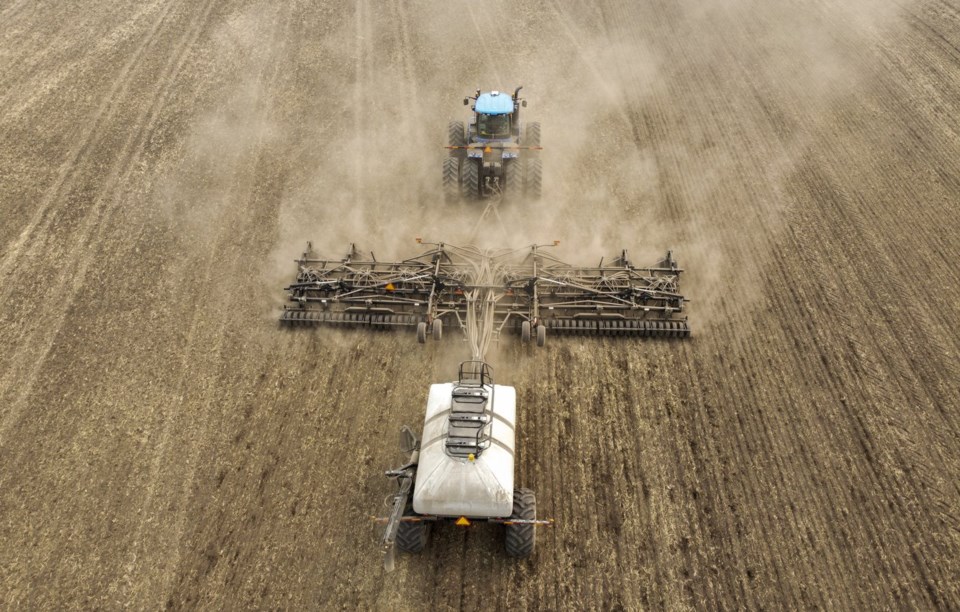CALGARY — A wetter-than-expected spring has Western Canadian farmers breathing a sigh of relief, but drought remains a significant worry.
After last year's hot, dry conditions on the prairies and below-average snowfall this winter, many farmers had been bracing for a possible repeat in 2024.
But spring has brought average or above-average precipitation to many agricultural areas, and producers who last year saw their crops wither in the fields or pastures dry up are feeling cautiously optimistic.
LeRoy Newman, who farms wheat, barley, canola and peas just south of Calgary, said last year's drought was so bad in his area that his 2023 crop was a "disaster." This spring's milder temperatures and series of gentle rainfalls have come as a big relief, he said.
"It's a win for everybody. Like, you don't hear of the severe forest fires, you don't hear of severe pasture problems — it's a positive," Newman said.
"My grandfather always said Mother Nature eventually corrects itself, and we were definitely due."
In Alberta, which endured some of Canada's most challenging drought conditions last year, concerns about what 2024 could bring were significant enough that the provincial government asked a special committee to come up with a response plan in case of a water shortage emergency.
But while welcome spring precipitation has eased those fears somewhat, the threat of drought lingers. Drought is cumulative, and parts of Western Canada have experienced drier-than-normal conditions over and over throughout the last decade.
This means that while it may seem as if recent rainfall has been plentiful, it has done little more than replenish the parched topsoil. The deep subsoil, which crops depend on for water and nutrients, remains in a significant moisture deficit.
"That's our big concern now," Newman said.
"We really haven't filled up the storage capacity of the soil at all. And if we get those hot, windy days in the summer, the plants will use up half an inch of water a day."
The federal government's most recent Drought Monitor report said that as of the end of April, "multi-year precipitation deficits" exist throughout much of Western Canada. It said despite much of the prairie region receiving 150 per cent of normal precipitation for the month, "extreme" and "exceptional" drought conditions persisted across parts of Alberta and B.C.
"Nearly all of Alberta is at risk of significant drought impacts," the report stated.
"Significant precipitation is still needed to see many of these impacts subside, especially regarding longer-term impacts across the province."
In its annual summer forecast released this week, The Weather Network said it expects a "typical summer" is expected across most of Alberta, but a "very warm summer" across Saskatchewan and Manitoba.
"Drought is a major concern, especially across northern areas (of the prairies)," the network said in a news release.
Agriculture and Agri-Food Canada currently projects crop production in Canada this year to be approximately 94.4 million tonnes, five per cent and four per cent higher than the five-year and ten-year average, respectively.
But that projection is dependent on "normal" weather conditions, the federal department warned in its May 21 outlook.
"The most significant climate-related risk (to Canadian crop production) remains widespread dry conditions across most of Western Canada," the department stated.
"Timely rains will be critical during the growing season to reach yield potential."
One of the hardest-hit sectors in recent years has been the cattle ranching industry. In southern Alberta and southwest Saskatchewan in particular, many ranchers last year ran out of grass for their animals, forcing them to either import feed at sky-high prices or sell their cattle for slaughter.
But Tyler Fulton, vice-president of the Canadian Cattle Association and a rancher in southwest Manitoba, said this year's conditions so far are completely different. On his own ranch, pasture conditions "really couldn't be better."
"And I've got a number of friends in southern and central Alberta and southern Saskatchewan, and they're all in a much, much better spot than last year," he said.
While he acknowledged that there's no guarantee what the rest of the spring and summer will bring, he said for the cattle industry, it's the early months of the growing season that matter most.
"The first month of growth for pasture and forage is the most critical by far. We'll produce more than half of (our pasture's) biomass in that first month," Fulton said.
"So we're set up really well."
This report by The Canadian Press was first published May 31, 2024.
Amanda Stephenson, The Canadian Press




